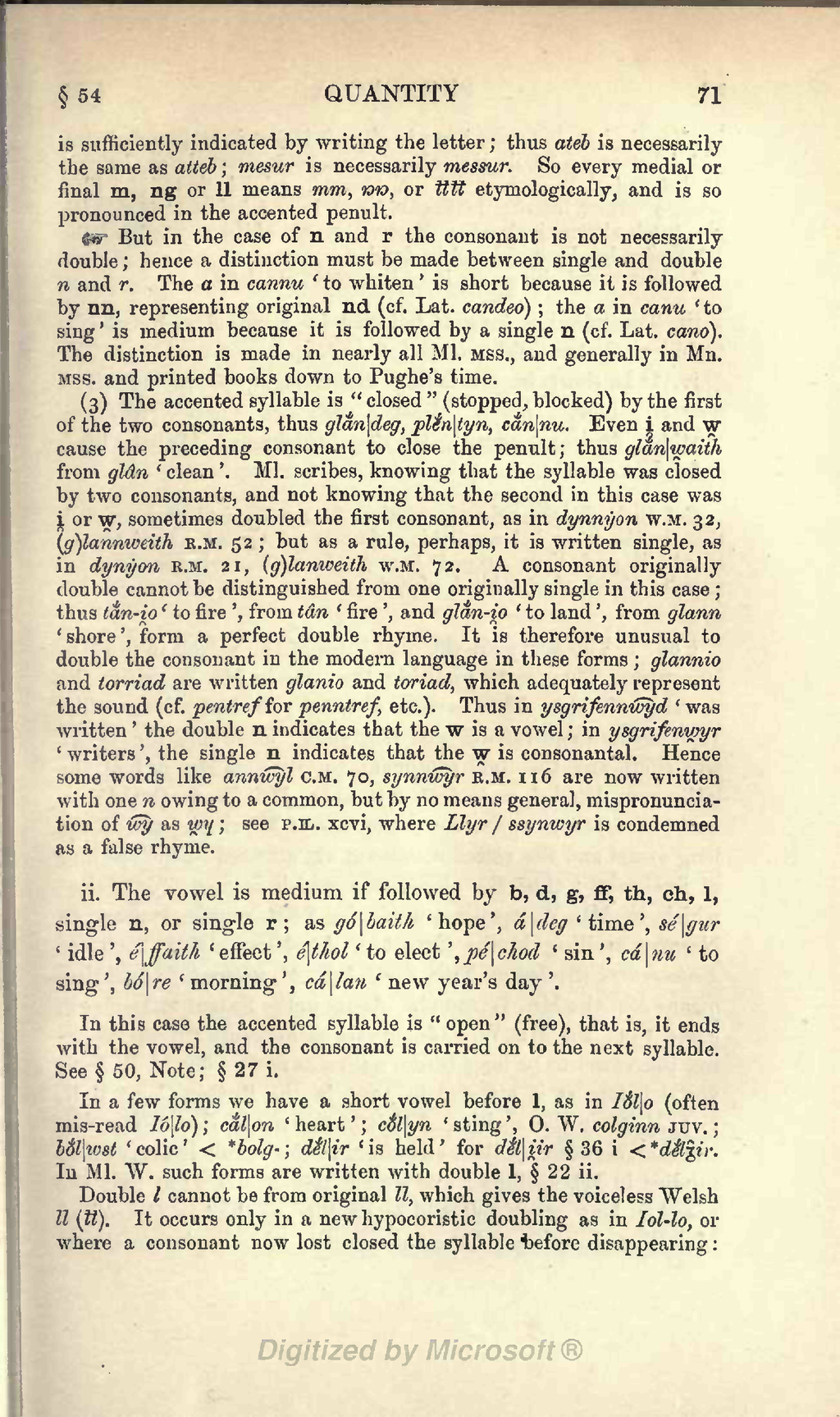is sufficiently indicated by writing the letter; thus ateb is necessarily the same as atteb; mesur is necessarily messur. So every medial or final m, ng or ll means mm, ŋŋ, or ỻỻ etymologically, and is so pronounced in the accented penult.
☞ But in the case of n and r the consonant is not necessarily douhle; hence a distinction must be made between single and double n and r. The a in cannu ‘to whiten’ is short because it is followed by nn, representing original nd (cf. Lat. candeo); the a in canu ‘to sing’ is medium because it is followed by a single n (cf. Lat. cano). The distinction is made in nearly all Ml. mss., and generally in Mn. mss. and printed books down to Pughe’s time.
(3) The accented syllable is “closed” (stopped, blocked) by the first of the two consonants, thus glắn|deg, plĕ́n|tyn, cắn|nu. Even i̯ and w̯ cause the preceding consonant to close the penult; thus glắn|w̯aith from glân ‘clean’. Ml. scribes, knowing that the syllable was closed by two consonants, and not knowing that the second in this case was i̯ or w̯, sometimes doubled the first consonant, as in dynnẏon w.m. 32, (g)lannweith r.m. 52; but as a rule, perhaps, it is written single, as in dynẏon r.m. 21, (g)lanweith w.m. 72. A consonant originally double cannot be distinguished from one originally single in this case; thus tắn-i̯o ‘to fire’, from tân ‘fire’, and glắ-i̯o ‘to land’, from glann ‘shore’, form a perfect double rhyme. It is therefore unusual to double the consonant in the modern language in these forms; glannio and torriad are written glanio and toriad, which adequately represent the sound (cf. pentref for penntref, etc.). Thus in ysgrifennw͡yd ‘was written’ the double n indicates that the w is a vowel; in ysgrifenw̯yr ‘writers’, the single n indicates that the w̯ is consonantal. Hence some words like annw͡yl c.m. 70, synnw͡yr r.m. 116 are now written with one n owing to a common, but by no means general, mispronunciation of w͡y as w̯ɥ; see P.Ỻ. xcvi, where Llyr / ssynwyr is condemned as a false rhyme.
ii. The vowel is medium if followed by b, d, g,[W 1] ff, th, ch, l, single n, or single r; as gó|baith ‘hope’, á|deg ‘time’, sé|gur ‘idle’, é|ffaith ‘effect’, é|thol ‘to elect’, pé|chod ‘sin’, cá|nu ‘to sing’, bó|re ‘morning’, cá|lan ‘new year’s day’.
In this case the accented syllable is “open” (free), that is, it ends with the vowel, and the consonant is carried on to the next syllable. See § 50, Note; 27 i.
In a few forms we have a short vowel before l, as in Iŏ́l|o (often mis-read Iô|lo); cắl|on ‘heart’; cŏ́l|yn ‘sting’, O. W. colginn juv.; bŏ́l|wst ‘colic’ < *bolg‑; dĕ́l|ir ‘is held’ for dĕ́l|i̯ir § 36 i <*dĕ́lᵹ̑ir. In Ml. W. such forms are written with double l, § 22 ii.
Double l cannot be from original ll, which gives the voiceless Welsh ll (ỻ). It occurs only in a new hypocoristic doubling as in Iol-lo, or where a consonant now lost closed the syllable before disappearing:- ↑ On p. xxvii the author says to add: “f, dd”.
